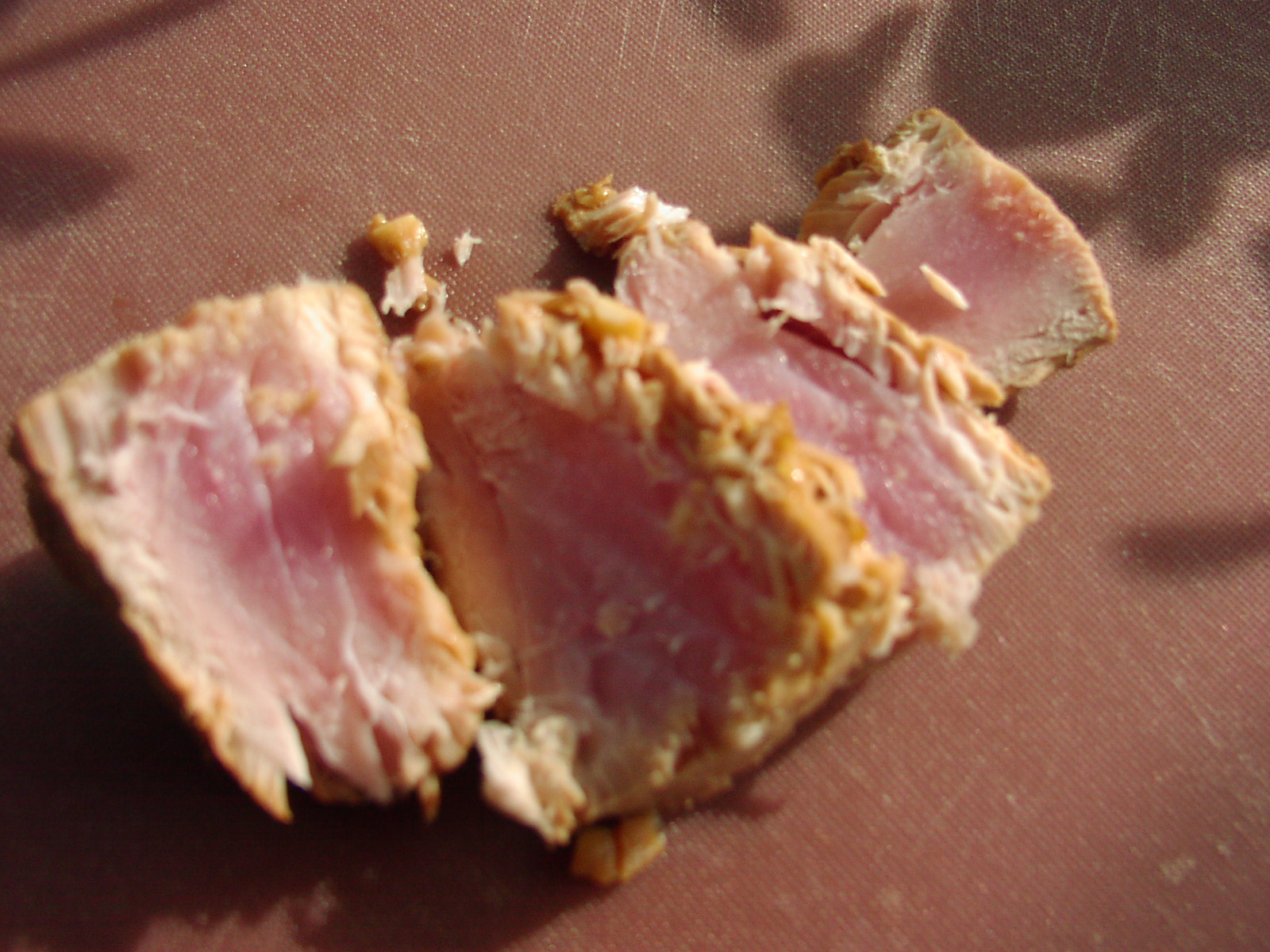
(Sorry about the fuzzy picture, but before I could take a picture, the tuna was all but consumed. Then before I could actually check to see if I had taken a decent enough picture, it was all gone!)
If there is anything better than having wonderful neighbors, I can’t think what it could possibly be? Except of course if said neighbors are also good friends AND bring you fresh tuna. Now that is what I call a winning combination.
So when Jerry and Jeanie got back from their fishing trip and asked if we would like some fresh tuna, we jumped at the chance. It isn’t just every day that we get to sink our teeth into such a delicacy. Plus this is a delicacy that takes very little effort or time to prepare. (Another winning combination!)
With such an amazing piece of fish (about 2 pounds), the last thing I wanted to do was prepare it in such a way as to spoil either the delicate flavor or moistness of the fish. So off to the internet in search of both elucidation and inspiration. I knew I wanted to either grill or sear the tuna, but did I want to marinate the fish or serve it with something like a wasabi aioli? After remembering that I wanted to cut down on the amount of sauces and aiolis I served, I decided that a marinade was the answer.
I was lucky enough to stumble on a Youtube by Chris Henry, a personal chef. The tuna she prepared on her video looked so delicious, I just knew it would be outstanding. And take it from me, this was the best tuna preparation I ever tasted, much less prepared myself. And like I mentioned; simple as can be.
So next time you want to treat your family and friends, I suggest you find yourself a lovely hunk of tuna and use this recipe. So thank you Chris for sharing your recipe. And thank you again Jerry and Jeanie for your lovely gift of tuna. But mainly, we both want to thank you for your friendship. It means more to us than even the sushi grade tuna you gave us. And that my dear friends, is saying a lot!
- 2 T. GF, low sodium Tamari
- 2 T. regular soy sauce
- juice of ½ of a lime
- 2 tsp. finely minced fresh ginger root
- 2 garlic cloves, finely minced
- 1 – 1½ lbs. fresh tuna fillets or steaks
- extra virgin olive oil
Combine the Tamari, soy sauce, lime juice, ginger, and garlic in a covered bowl or airtight freezer bag. Add the tuna and place in refrigerator for an hour or up to 4 hours (if the steaks are really thick). Remove from refrigerator about 30 minutes before you plan to cook the steaks. (I marinated 1½-inch steaks for 2 hours the other evening and they were perfect!)
Remove the steaks from marinade. Discard marinade.
Coat a medium sized fry pan with olive oil. Heat the oil until just before it starts to smoke. Fry the steak(s) for about 1½ – 2 minutes on each side or until the internal temperature reaches between 115 and 120 degrees.* (You never want to overcook tuna. So this is one of those times when an instant read thermometer is worth its weight in gold!) Remove tuna from pan, let sit for 3-4 minutes, then slice thinly against the grain. Serve immediately.
Please note: the marinade gives the tuna a wonderful flavor. In my estimation no other condiment or sauce is necessary, in fact it might detract from the glorious flavor of the fish.
*To cook and serve rare tuna, the tuna must be free of parasites. In order to do that, the just caught tuna must either be frozen at -4° F for 7 days or frozen at -31° F (“flash frozen”) for 15 hours. Even if the tuna in your store is marked “sushi or sashimi grade” (considered safe to be eaten raw) you can’t always be sure you are receiving a safe product.
According to Marc Matsumoto, “The term “sushi-grade” is often tossed around to imply some level of freshness, but in the US, there’s no regulation around the use of the phrase, so it can be used to describe anything. That said, most stores aren’t in the business of getting their customers sick, so they usually reserve the label for their freshest fish.” (Which I have discovered in my research doesn’t mean the fish is free of parasites. It just means it’s “fresher” than the fish that isn’t labeled “sashimi or sushi grade”!)
So moral of the story: Trust your fishmonger and buy tuna from a reliable source or buy commercially frozen fish.
